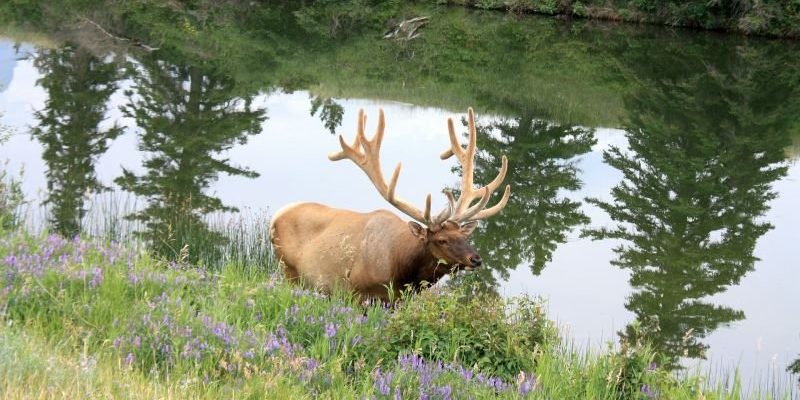
Think of wapitis as the cowboys of the forests—they prefer expansive, open spaces but also appreciate the shelter of wooded areas. This blend of habitats allows them to thrive, find food, and escape predators. In this article, we’ll dive into the habitat and distribution of wapitis, exploring their preferred environments and the regions where they can be found. Let’s embark on this journey through their world!
Understanding Wapiti Habitats
When we talk about wapiti habitats, we’re essentially discussing the environments that provide them with the essentials for survival: food, water, and shelter. Generally, wapitis thrive in a mix of forests, meadows, and open plains. They are adaptable creatures, meaning they can live in various climates, from the cool forests of the Pacific Northwest to the rugged terrain of the Rockies.
Wapitis often seek out grassy areas for grazing. You might find them munching on grasses, leaves, and shrubs in open meadows, especially during spring and summer when vegetation is lush. They also enjoy deciduous and mixed coniferous forests, where they can find shelter and shade. Here’s a fun fact: during the colder months, wapitis may migrate to lower elevations to escape heavy snow, showcasing their adaptability to changing environments.
Wapiti Distribution Across North America
Wapitis are primarily found across North America. You can spot them in the western United States, Canada, and even parts of Mexico. Each area hosts unique populations adapted to local conditions. For instance, in the Rocky Mountains, you’ll find larger wapiti herds that benefit from the mountainous terrain and plentiful grazing grounds.
In Canada, wapitis are more widespread, inhabiting places like Banff National Park and Jasper National Park. These parks preserve their habitats, allowing them to flourish while providing an opportunity for wildlife enthusiasts to see them in their natural settings. Interestingly, wapiti were once nearly extinct due to overhunting, but conservation efforts have helped their populations rebound in many regions.
Specific Habitat Preferences of Wapitis
When it comes to habitat preferences, wapitis are quite particular. Though they can adapt to various environments, they favor specific features that enhance their living conditions. Here are some key aspects of their preferred habitats:
- Food Availability: As grazers, wapitis thrive in areas where grasses and other vegetation are abundant. They need a reliable food source to support their size and energy needs.
- Water Sources: Access to water is crucial. Wapitis often settle near rivers, lakes, or streams, where they can quench their thirst and find moist vegetation.
- Cover for Safety: Dense forests or shrubbery provide cover against predators. Wapitis often select areas with a mix of open and wooded spaces, giving them the best of both worlds.
These preferences mean that if you’re looking for wapitis, keep an eye out for them in forest fringes or open meadows near water sources. You might find them during the early morning or late evening when they’re most active!
Wapiti Populations Around the World
While wapitis are predominantly found in North America, they share their family tree with various subspecies across the world. For instance, the Sika deer in Asia and red deer in Europe share genetic similarities. However, wapitis (Cervus canadensis) stand out due to their size and distinctive antler shape.
In Asia, you can also find similar species adapted to local environments, such as the Manchurian wapiti. Each subspecies has unique characteristics and habitats, showing just how adaptable these animals can be. Here’s the thing: while they thrive in many places, their primary populations remain here in North America, where they have the most secure and well-defined habitats.
Challenges to Wapiti Habitats
Despite their adaptability, wapitis face several challenges in their habitats. Habitat loss due to urban development, agriculture, and climate change poses significant threats. As more land is converted for human use, wapitis lose both their grazing areas and crucial cover from predators.
Another challenge is overpopulation and competition. In areas where wapiti populations grow too large, they can overgraze, leading to food shortages. This can create a ticking clock for their health and survival. Conservation efforts are important in these regions, helping to balance populations and ensure their habitats remain healthy and viable.
Conservation Efforts for Wapiti
Thankfully, many organizations work tirelessly to protect wapiti and their habitats. National parks and wildlife reserves play a crucial role in safeguarding these animals. By creating protected environments, wildlife officials can monitor populations and manage resources effectively.
Additionally, local communities often engage in awareness programs that educate people about the importance of wapitis in the ecosystem. When people understand the beauty and necessity of these creatures, they’re more likely to advocate for their protection. Let me explain: when we preserve wapiti habitats, we’re not just saving one species; we’re protecting a whole ecosystem that relies on a delicate balance of life.
Wapitis are more than just impressive animals; they are an essential part of our natural world. By understanding where wapitis live and the habitats they thrive in, we can appreciate the intricate connections between wildlife and their ecosystems. From the lush meadows of North America to the conservations efforts that ensure their survival, knowing about wapitis opens our eyes to the beauty of nature that surrounds us.
As we continue to protect their habitats, we also help maintain biodiversity and the health of our environment. So, next time you think about these majestic creatures, remember that they rely on us just as much as we admire them. Let’s keep our wilderness wild for wapitis and many other species to enjoy for generations to come!

